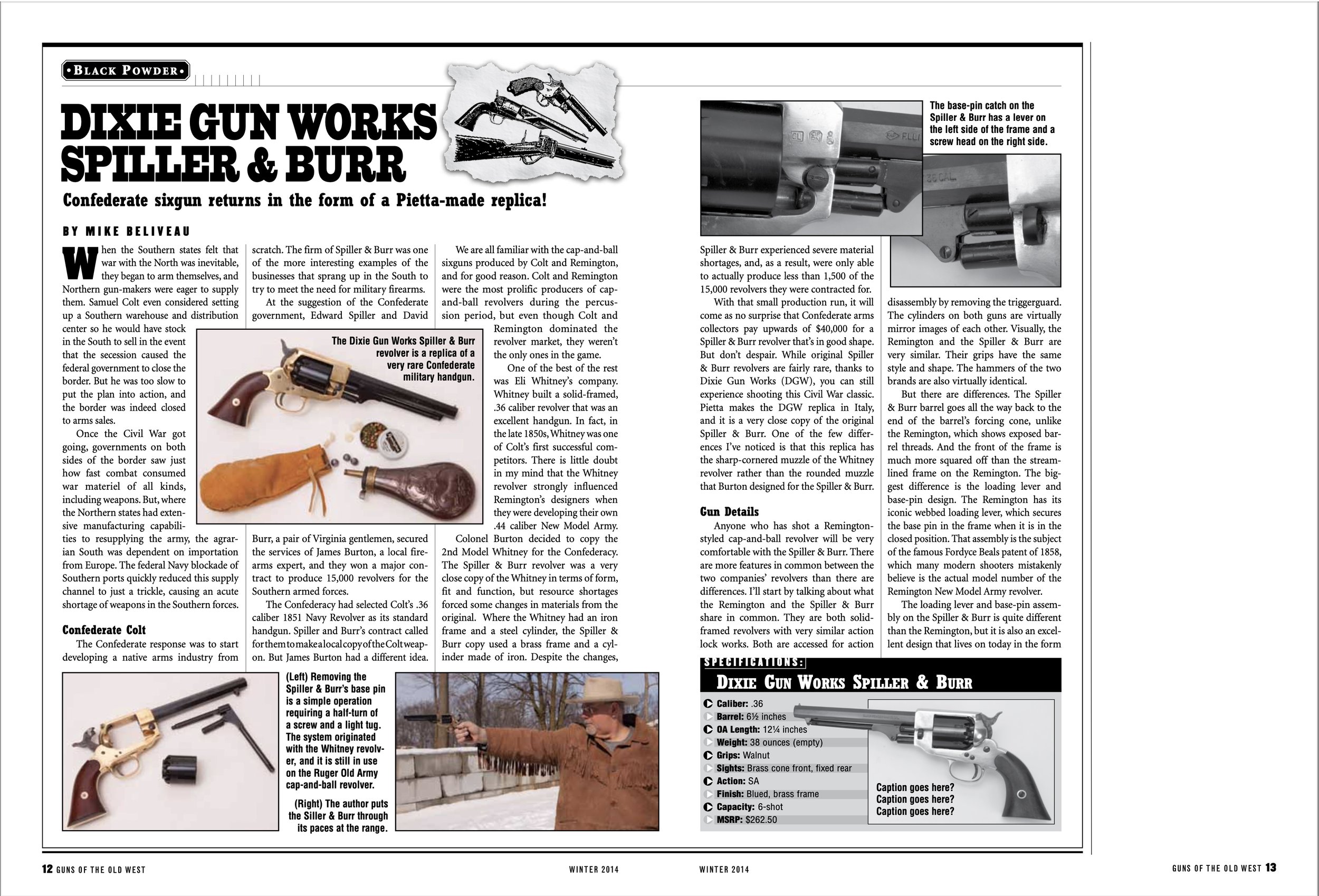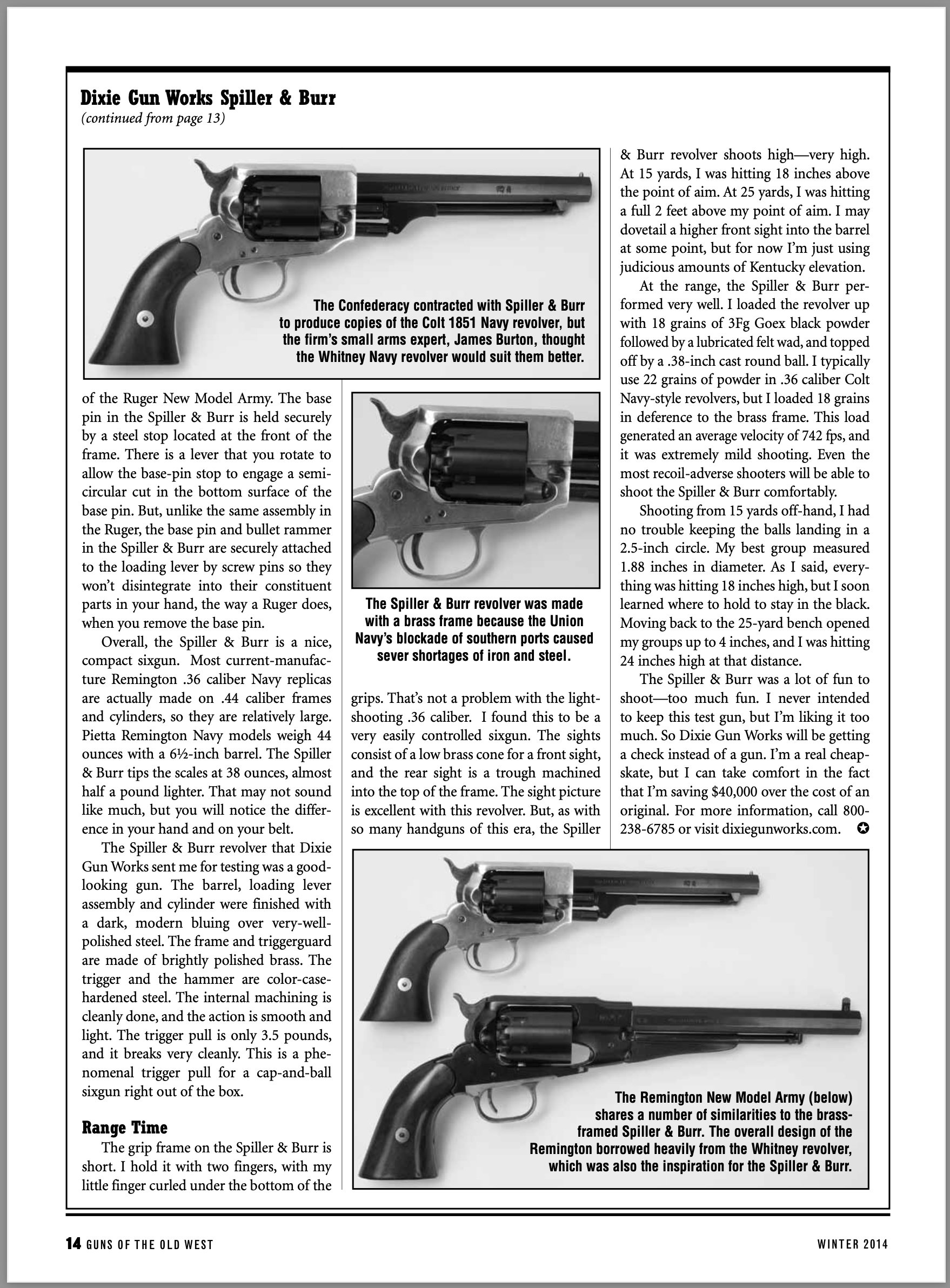Dixie Gun Works Spiller & Burr Confederate Revolver
Confederate sixgun returns as a Pietta-made replica
When the southern states felt that war with the north was inevitable, they began to arm themselves, and northern gun makers were eager to supply them. Samuel Colt even considered setting up a southern warehouse and distribution center, so he would have stock in the south to sell in the event that the secession caused the federal government to close the border. But he was too slow to put the plan into action, and the border was indeed closed to arms sales.
Once the Civil War got going governments on both sides of the border saw just how fast combat consumed war materiel of all kinds, including weapons. But, where the northern states had extensive manufacturing capabilities to apply to re-supplying the army, the agrarian south was dependent on importation from Europe. The Federal Navy blockade of southern ports quickly reduced this supply channel to just a trickle, causing an acute shortage of weapons in the southern forces.
The Confederate response was to start developing a native arms industry from scratch. The firm of Spiller & Burr was one of the more interesting examples of the businesses that sprang up in the south to try to meet the need for military firearms.
At the suggestion of the Confederate government, Edward Spiller and David Burr, a pair of Virginia gentlemen, secured the services of James Burton, a local firearms expert, and they won a major contract to produce 15,000 revolvers for the southern armed forces.
The Confederacy had selected Colt’s .36 caliber 1851 Navy Revolver as its standard handgun. Spiller and Burr’s contract called for them to make a local copy of the Colt weapon. But James Burton had a different idea.
We are all familiar with the cap and ball sixguns produced by Colt and Remington, and for good reason. Colt and Remington were the most prolific producers of cap and ball revolvers during the percussion period, even though Colt and Remington dominated the revolver market, they weren’t the only ones in the game.
One of the best of the rest was Eli Whitney’s company. Whitney built a solid framed, .36 caliber revolver that was an excellent handgun. In fact, in the late 1850’s, Whitney was one of Colt’s first successful competitors. There is little doubt in my mind that the Whitney revolver strongly influenced Remington’s designers when they were developing their own .44 caliber New Model Army.
Colonel Burton decided to copy the Second Model Whitney for the confederacy. The Spiller & Burr revolver was a very close copy of the Whitney in terms of form, fit and function, but resource shortages forced some changes in materials from the original. Where the Whitney had an iron frame and a steel cylinder, the Spiller & Burr copy used a brass frame and a cylinder made of iron. Despite the changes, Spiller & Burr experience severe material shortages, and, as a result, were only able to actually produce less than 1,500 of the 15,000 revolvers they were contracted for.
With that small production run, it will come as no surprise that Confederate arms collectors pay upwards of $40,000 for a Spiller & Burr revolver that’s in good shape. But don’t despair. While original Spiller & Burr revolvers are fairly rare, Thanks to Dixie Gun Works, you can still experience shooting this Civil War classic. Pietta makes the DGW replica in Italy, and it is a very close copy of the Spiller & Burr. One of the few differences I’ve noticed is that this replica has the sharp cornered muzzle of the Whitney revolver, rather than the rounded muzzle that Burton designed for the Spiller & Burr.
Anyone who has shot a Remington styled cap and ball revolver will be very comfortable with the Spiller & Burr. There are more features in common between the two companies’ revolvers than there are differences. I’ll start by talking about what the Remington and the Spiller & Burr share in common. They are both solid framed revolvers with very similar action lock work. Both are accessed for action disassembly by removing the trigger guard. The cylinders on both guns are virtually mirror images of each other. Visually the Remington and the Spiller & Burr are very similar. They have the same style and shape grips. The hammers of the two brands are virtually identical.
But there are differences. The Spiller & Burr goes all the way back to the end of the barrel’s forcing cone, unlike the Remington, which shows exposed barrel threads. And the front of the frame is much more squared off than the streamlined frame on the Remington. The biggest difference is the loading lever and basepin design. The Remington has its iconic webbed loading lever which secures the basepin in the frame when it is in the closed position. That assembly is the subject of the famous Fordyce Beals patent of 1858, which many modern shooters mistakenly believe is the actual model number of the Remington New Model Army revolver.
The loading lever and basepin assembly on the Spiller & Burr is quite different than the Remington, but it is also an excellent design that lives on today in the form of the Ruger New Model Army. The basepin in the Spiller & Burr is held securely by a steel stop located at the front of the frame. There is a lever that you rotate to allow the basepin stop to engage a semi-circular cut in the bottom surface of the basepin. But, unlike the same assembly in the Ruger, the basepin and bullet rammer in the Spiller & Burr are securely attached to the loading lever by screw pins, so they won’t disintegrate into their constituent parts in your hand, the way a Ruger does, when you remove the basepin.
Overall the Spiller & Burr is a nice, compact sixgun. Most current manufacture Remington .36 caliber Navy replicas are actually made on .44 Caliber frames and cylinders, so they are relatively. Pietta Remington Navies weigh two pounds 12 ounces with a six and a half inch barrel. The Spiller & Burr tips the scales at two pounds, six ounces, almost half a pound lighter. That may not sound like much, but you will notice the difference in your hand, and on your belt.
The Spiller & Burr revolver that Dixie Gun Works sent us was a good looking gun. The Barrel, loading lever assembly and cylinder were finished with a dark modern hot bluing over very well polished steel. The frame and trigger guard are made of brightly polished brass. The trigger and the hammer are color case hardened steel. The internal machining is cleanly done, and the action is smooth and light. The trigger pull is only three and a half pounds, and it breaks very cleanly. This is a phenomenal trigger pull for a cap and ball sixgun right out of the box.
The grip frame on the Spiller & Burr is short. I hold it with two fingers, and with my little finger curled under the bottom of the grips. That’s not a problem with the light shooting .36 caliber. I found this to be a very easily controlled sixgun. The sights consist of a low brass cone for a front sight, and the rear sight is a trough machined into the top of the frame. The sight picture is excellent with this revolver. But, as with so many handguns of this era, the Spiller & Burr revolver shoots high…very high. At 15 yards I was hitting 18 inches above the point of aim. At 25 yards I was hitting a full two feet above my point of aim. I may dovetail a higher front sight into the barrel at some point, but, for now, I’m just using judicious amounts of Kentucky elevation.
At the range the Spiller & Burr performed very well. I loaded the S&B up with 18 grains of 3Fg Goex black powder followed by a lubricated felt wad, and topped off by a .380-inch cast round ball. I typically use 22 grains of powder in .36 caliber Colt Navy style revolvers, but I loaded 18 grains in deference to the brass frame. This load generated an average velocity of 742 feet per second, and it was extremely mild shooting. Even the most recoil adverse shooters will be able to shoot the Spiller & Burr comfortably.
Shooting from 15 yards off hand I had no trouble keeping the balls landing in a two and a half inch circle. My best group measured one and seven-eights inches in diameter. As I said, everything was hitting 18 inches high, but I soon learned where to hold to stay in the black. Moving back to the 25-yard bench opened groups up to four inches, and I was hitting 24 inches high at that distance.
The Spiller & Burr was a lot of fun to shoot…too much fun. I never intended to keep this test gun, but I’m liking it too much. So Dixie Gun Works will be getting a check, instead of a gun. I’m a real cheapskate, but I can take comfort in the fact that I’m saving $40,000 over the cost of an original.
Dixie Gun Works Spiller & Burr revolver
Caliber: .36
Barrel: 6.5 inches
OA Length: 12.25 inches
Weight: 2 pounds 6 ounces
Capacity: 6 rounds
Sights: Brass cone front sight, fixed rear sight
Finish: Brass frame, , balance blued steel
Action: Single action revolver
Stocks: Two-piece walnut
Dixie Gun Works Inc.
1412 West Reelfoot Ave.
Union City, TN 38218
800-238-6785

